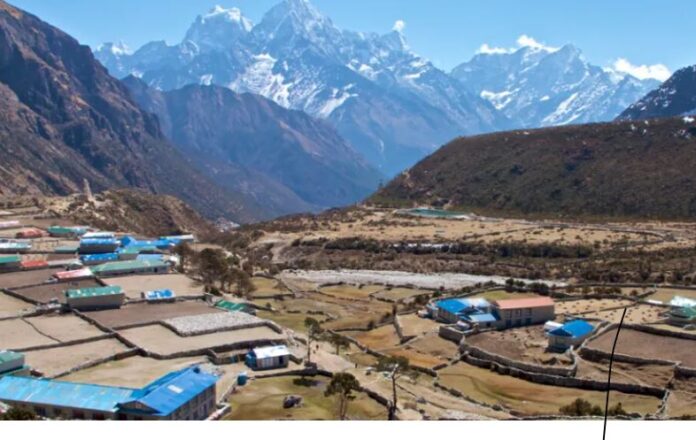The Himalayan village of Thame in Nepal, once a serene settlement nestled in the foothills of Mount Everest, was devastated by a sudden flood caused by a glacial lake burst in August. The muddy torrent, fueled by climate change-induced glacier melt, engulfed the village, wiping out homes, livelihoods, and a school established by legendary mountaineer Sir Edmund Hillary.
Mingma Rita Sherpa, a local resident, returned to find his home and village unrecognizable. “There is no trace of our house… nothing is left,” he said. “It took everything we owned.” The disaster has left the villagers fearing further floods from unstable glacial lakes perched above them.
Nepal has been grappling with severe flooding this year, with the latest disaster following months of torrential monsoon rains that have killed over 236 people across the country. Thame, known for its mountaineering heritage, was one of the many areas impacted, as half of its homes, a clinic, and a key hydropower plant were destroyed by the glacial flood.
The flood in Thame is part of an alarming trend of glacial lake outburst floods (GLOFs), a growing threat as climate change accelerates glacier melting in the Himalayas. These lakes, formed by retreating glaciers, are often dammed by unstable ice or debris, making them prone to sudden releases of water.
Scientists warn that the risks are increasing. More than 2,000 glacial lakes have been mapped across Nepal, with 21 identified as potentially dangerous, according to the International Centre for Integrated Mountain Development (ICIMOD). The government has previously drained some of these lakes to mitigate risks, and plans are underway to drain at least four more.
“The risks are there… so our mountain communities must be made aware so they can be prepared,” said Sudan Bikash Maharjan, a geologist at ICIMOD. He emphasized the need for improved monitoring systems to predict and mitigate the impact of future floods.
For the residents of Thame, rebuilding remains a challenge. Many have relocated to neighboring villages or the capital, Kathmandu, as the land in their village continues to erode. “We are afraid to return, there are still lakes above,” said Mingma Nuru Sherpa, another resident. “The fertile land is gone. It is hard to see a future there.”
Veteran mountaineer Kami Rita Sherpa, who recently climbed Everest for a record 30th time, is leading efforts to raise funds for his village. He warned that the dangers posed by climate change extend beyond Thame, threatening villages throughout the region. “We are living at risk – not just Thame, other villages downhill also need to be alert,” he said. “The Himalayas have changed… We have now not only seen the impact of climate change, but experienced its dangerous consequences too.”
As Nepal continues to confront the realities of a warming planet, experts warn that the current situation is only the beginning. While glacial melt may cause destructive floods now, the eventual depletion of these glaciers could bring even greater threats to the millions of people who depend on the water they provide across South Asia.
Key Points: Nepalis Fear Devastating Floods Due to Climate Change
- Glacial Lake Outburst in Thame:
- The village of Thame, located in the foothills of Mount Everest, was devastated in August by a sudden flood from a glacial lake burst.
- The flood destroyed homes, a clinic, a school, and a hydropower plant, with no fatalities reported.
- Many residents, including Mingma Rita Sherpa, have been displaced and fear returning due to ongoing risks.
- Impact of Climate Change:
- The flood is linked to climate change, with scientists warning that melting glaciers due to rising temperatures are forming unstable glacial lakes.
- These lakes, dammed by ice and loose debris, pose a significant threat to communities like Thame.
- Nepal has experienced its worst flooding in decades, exacerbated by ferocious monsoon rains, claiming at least 236 lives this year.
- Glacial Lake Outburst Floods (GLOFs):
- GLOFs, such as the one in Thame, are becoming more frequent as glaciers retreat at an alarming rate.
- The International Centre for Integrated Mountain Development (ICIMOD) has mapped over 2,000 glacial lakes in Nepal, with 21 identified as highly dangerous.
- Nepalese authorities are planning to drain at least four more lakes to mitigate future flood risks.
- Displacement and Uncertain Future:
- Many residents of Thame have relocated to neighboring villages or Kathmandu, as the land continues to erode and remains unstable.
- The flood has severely impacted the local economy, with many residents like Mingma Nuru Sherpa, who operated lodges for trekkers, facing an uncertain future.
- Broader Regional Risks:
- Scientists warn of a two-phase impact from climate change in the region: initially, melting glaciers will cause destructive floods, followed by the eventual depletion of glaciers, which would reduce water supply for millions in South Asia.
- The Himalayas provide water to approximately 240 million people in the mountain regions, and another 1.65 billion people in the river valleys below, making this a critical issue.
- Call for Increased Monitoring and Preparedness:
- Experts like Sudan Bikash Maharjan of ICIMOD emphasize the need for improved monitoring systems to better predict and prepare for future GLOFs.
- Community awareness and preparedness are crucial to minimizing the risks posed by these natural disasters.
- Fundraising Efforts and Warnings:
- Mountaineer Kami Rita Sherpa, who holds the record for climbing Everest 30 times, is leading fundraising efforts to support his village.
- He warns that not only Thame but other villages in the region are at risk, and that climate change has fundamentally altered the Himalayan environment.



